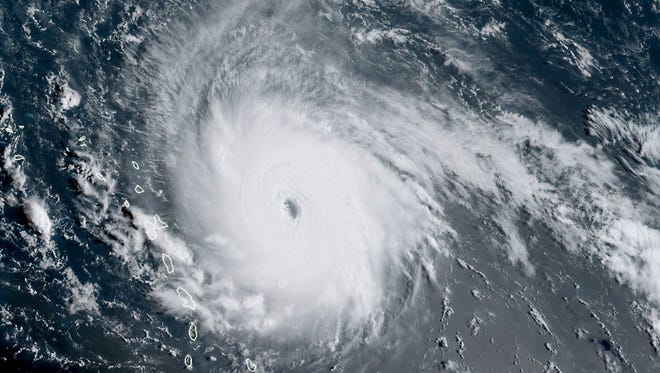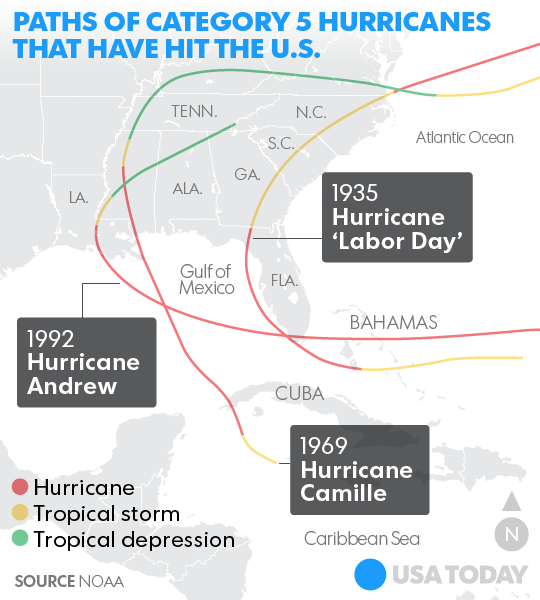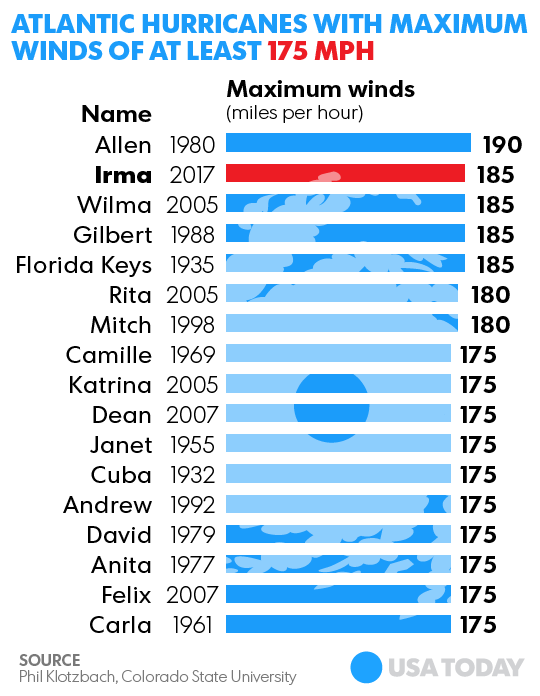Meteorological monsters: Only 3 Category-5 hurricanes have ever hit the U.S.
 Doyle Rice
Doyle Rice
It's been 25 years since a Category 5 hurricane struck the U.S., and Irma could potentially become just the fourth storm of that strength to barrel into the states.
Hurricane Irma is a monster storm in the Atlantic with maximum sustained winds of 185 mph. Only one Atlantic hurricane on record, Allen in 1980, contained stronger winds, at 190 mph.
The only Category 5 hurricanes to hit the U.S. are Andrew in 1992, Camille in 1969 and an unnamed storm in 1935.
Hurricane Irma:What we know now and where it's headed next
Emergency kits:How to prepare for a hurricane
After tearing through the Caribbean, Irma could potentially slam into the U.S. by the weekend or early next week. However, it's expected — for now — to lose some steam, becoming a Category 4 before it nears the U.S.
The five hurricane categories of the Saffir-Simpson hurricane scale are defined solely by wind speed, and don't take storm surge, heavy rain or barometric pressure into account. Any hurricane with winds of 157 mph or greater is a Category 5.
More:How your smartphone can help in an emergency
More:What you need to know about flood insurance
These monster storms cause "catastrophic damage," the National Hurricane Center said. Category 5 hurricanes destroy a high percentage of homes, often causing total roof failure and wall collapses. Fallen trees and power poles isolate residential areas. Power outages last for weeks or months. And areas can be uninhabitable for the same time frame.

1935 'Labor Day' hurricane
The strongest hurricane on record to hit the U.S. roared into the Florida Keys on Sept. 2, 1935. The storm was later nicknamed the Florida Keys or Labor Day hurricane because of where and when it hit.
The hurricane rushed ashore as a Category 5 hurricane, with sustained winds of 185 mph as it crossed the Florida Keys between Key West and Miami.
The ferocious storm killed 423 people, including 259 World War I veterans living in camps while building the highway to Key West.
Many victims drowned, some swept into the Gulf of Mexico, others sucked back into the Atlantic after the 15-foot wave passed, the Associated Press said. Some people were literally sandblasted to death.
Although the 1935 storm may have been the strongest, it was far from the deadliest. The hurricane that flattened Galveston, Texas, in 1900 killed an estimated 6,000 to 8,000 people.
From Camille to Andrew
Hurricane Camille struck the Gulf Coast of the U.S. on Aug. 18, 1969, with winds estimated at 175 mph and gusts of 200 mph.
Storm surge — the wall of ocean water that comes ashore with the hurricane — caused utter devastation in coastal Mississippi. Torrential rain from Camille led to additional flooding and deaths well inland as the storm crossed Virginia's Appalachian Mountains. In all, Camille killed 259 people.
Hurricane Andrew's 165 mph winds roared into Florida on Aug. 24, 1992. The fast-moving, tightly wound hurricane tore through South Florida in the middle of the night, leveling entire neighborhoods, tossing boats and mobile homes and leaving millions of people without power or hope.
In all, Andrew killed 65 people and caused $27 billion in damage.
Katrina, the costliest natural disaster in U.S. history at $125 billion, "only" measured as a Category 3 at landfall, demonstrating some of the flaws in the wind scale. Storm surge and the levees that failed in New Orleans — not wind or rain — caused much of the devastation.
